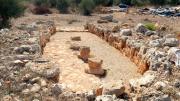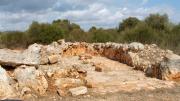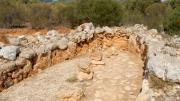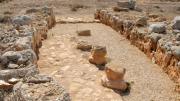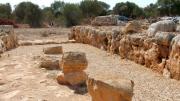Portocolom:
CLOSOS DE CA'N GAIÀ
The site of the "Closos de Ca'n Gaia" is one of the largest Naveta finds on Mallorca. Its origin can be dated back to around 1,700 BC, the beginning of the Bronze Age on Mallorca. Towards the end of 850 BC, permanent settlement ceased relatively suddenly, at a time when there were already the first Talaiotic settlements on the island.In total, the remains of about ten buildings have been found here, most of which are still overgrown with undergrowth. The first cleaning and surveying work took place in 1967, but it was not until 1996 that the University of Palma (UIB) began systematic excavations here. Apart from a small amount of pottery from the transition from the Pretalaiotic to the Talaiotic period, no significant finds have come to light so far.
But the navetas themselves are very interesting. The best excavated and conserved naveta has an interior space sixteen meters long and seven meters wide. Its outer wall has a total thickness of two to three meters and is partially preserved up to a height of 1.5 m. The outer wall is made of rough stones, while the inner one is much finer. Smaller stones were used here, which are excellently processed. The space between them was filled with earth, as was the case later with the talaiots. About half of the original flat stone floor has been preserved and is in very good condition. The fact that four supporting columns were built into this naveta, instead of the usual one or two, suggests that these could have supported not only the roof but also an upper floor. Holes found opposite the entrance may have held posts on which the floor of the upper storey rested as a canopy. Traces of a fire were found under the floor tiles in the entrance area of the building. Perhaps the remains of a fire ceremony to inaugurate or protect the naveta.
< Son Real



